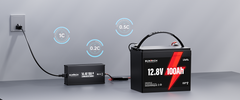
What is Battery C-Rate and Why It Matters
, 6 min reading time


, 6 min reading time
Ever wondered why some batteries charge faster, power devices longer, or fail unexpectedly? The answer lies in C-Rate—a critical yet often overlooked battery specification. Whether you're running a solar power system, an RV, or backup energy storage, understanding C-Rate helps you:
✔ Optimize charging speed
✔ Maximize power output
✔ Avoid premature battery failure
✔ Ensure safety
Let’s break it down.
Definition
C-Rate measures how fast a battery can charge or discharge relative to its total capacity.
How It Works
1C = Full charge/discharge in 1 hour
0.5C = Full charge/discharge in 2 hours
2C = Full charge/discharge in 30 minutes
Formula
Current (A) = C-Rate × Battery Capacity (Ah)
Example
A 100Ah battery at 1C delivers 100A
The same battery at 0.5C delivers 50A
C-Rate vs. Output Current (100Ah Battery Example)
|
C-Rate |
Output Current (A) |
Approx. Charge/Discharge Time |
|
0.2C |
20A |
5 hours |
|
0.5C |
50A |
2 hours |
|
1C |
100A |
1 hour |
|
2C |
200A |
30 minutes |
Discharge C-Rate
Charge C-Rate
Reading Battery Specs:
Look for:
✔ Max continuous discharge current → Max safe discharge C-Rate
✔ Recommended charging current → Safe charge C-Rate
100Ah Battery Examples
0.5C → 50A (2-hour runtime)
1C → 100A (1-hour runtime)
2C → 200A (30-minute runtime)
Recommended C-Rates by Use Case
|
Application |
Recommended C-Rate |
Why? |
|
Solar Storage |
0.2C – 0.5C |
Long lifespan, stable output |
|
RV & Camping |
0.5C – 1C |
Balanced power & charging |
|
Backup Power |
0.2C – 1C |
Reliable, long runtime |
|
Power Tools / Drones |
5C – 20C |
High burst power needed |
Warning: Using the wrong C-Rate can overload or underutilize your battery!
Risks of High C-Rates
⚡Heat buildup → Degrades battery
⚡Capacity fade → Shorter lifespan
⚡Safety hazards → Swelling, leaks, fires
Cycle Life Example
For example, a battery rated for 4000 cycles at 0.5C may see its cycle life reduced to around 2000 cycles when regularly charged or discharged at 1C or higher.
Pro Tip: Use a Battery Management System (BMS) to monitor and limit C-Rate.Most modern LiFePO₄ batteries already come with an integrated BMS.
|
Battery Type |
Typical C-Rate Range |
Best For |
|
Lead-Acid |
0.05C – 0.3C |
Low-cost, slow discharge |
|
Li-ion (NMC) |
0.5C – 1.5C |
High energy, moderate speed |
|
LiFePO₄ |
0.5C – 2C |
Best for solar, RVs, off-grid |
High-C-Rate Batteries (5C–30C) are used in:
Drones
RC cars
Power tools
Tips: But for most users, LiFePO₄ batteries offer the ideal balance of safety, speed, and durability.
✔ Max 1C charge/discharge rate (100A)
✔ Standard 0.5C charging (50A) for balanced performance
✔ Integrated heating for safe charging in cold climates
✔ Smart BMS protection: Overvoltage, low-temp, short circuit
✔ Long cycle life: 4000+ cycles at 0.5C
✔ Ideal for RVs, solar systems, and off-grid applications
Bonus: Heating is automatic—no manual switching required!
Before buying or using a battery, ask yourself:
1. What’s my peak power draw? (Add all device loads)
2. How long do I need power? (Higher C-Rate = shorter runtime)
3. Does my inverter/BMS support it?
4. What’s the battery’s max C-Rate?
* Never exceed the rated C-Rate—risk of damage or failure!
✔ C-Rate = Speed at which a battery is charged or discharged
✔ Impacts power delivery, charge time, battery life, and safety
✔ Match your application needs to a battery’s rated C-Rate
✔ LiFePO₄ batteries, like Sunrich Energy’s, offer high performance and safety
✔ Don’t guess—calculate your system load and choose the right specs!
Whether you’re powering a solar setup, RV, or backup system, choosing the right C-Rate ensures longer life, better performance, and safety.
Check out Sunrich Energy's LiFePO₄ Heated Battery for high-performance, cold-weather-ready energy storage!